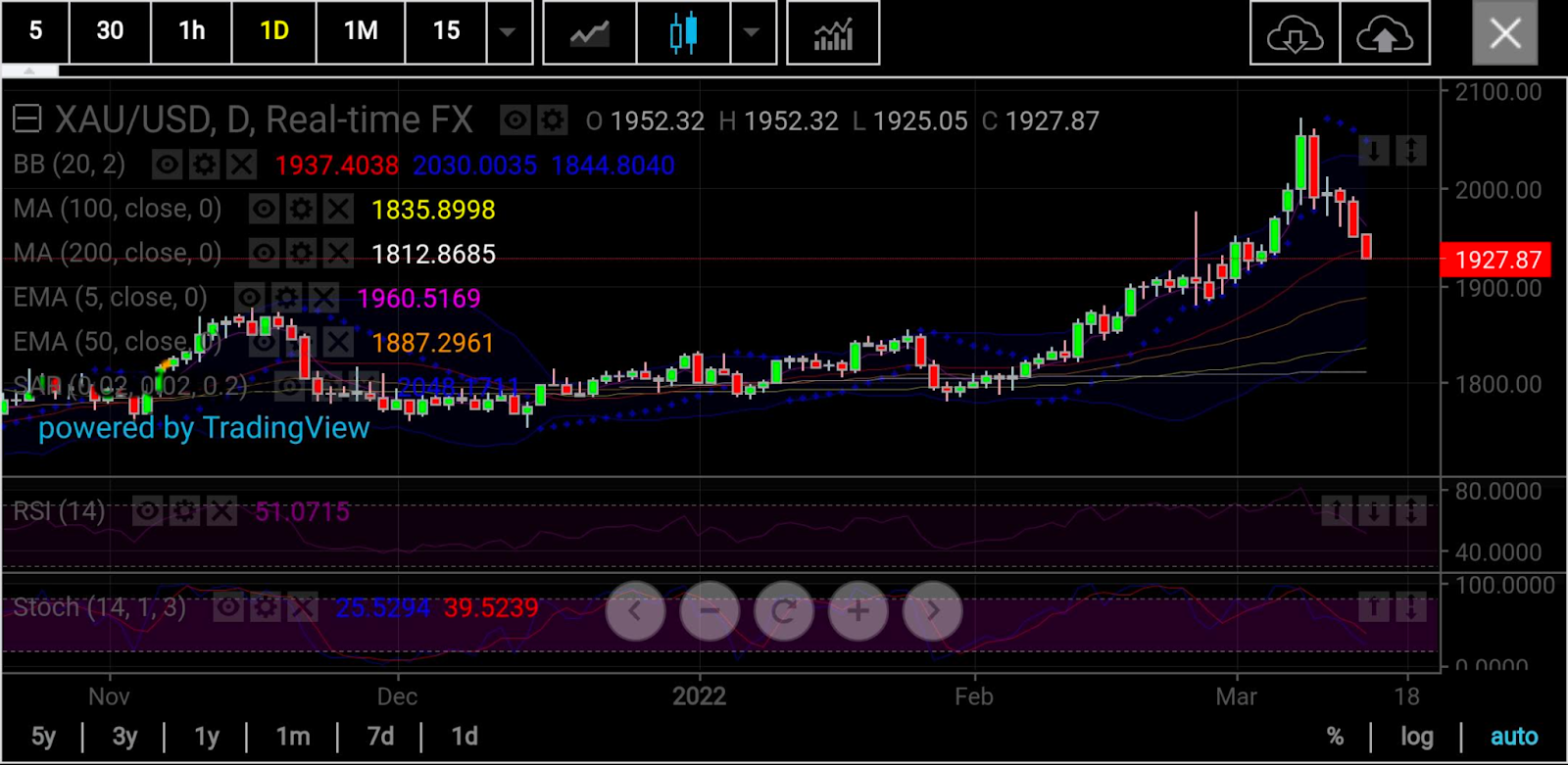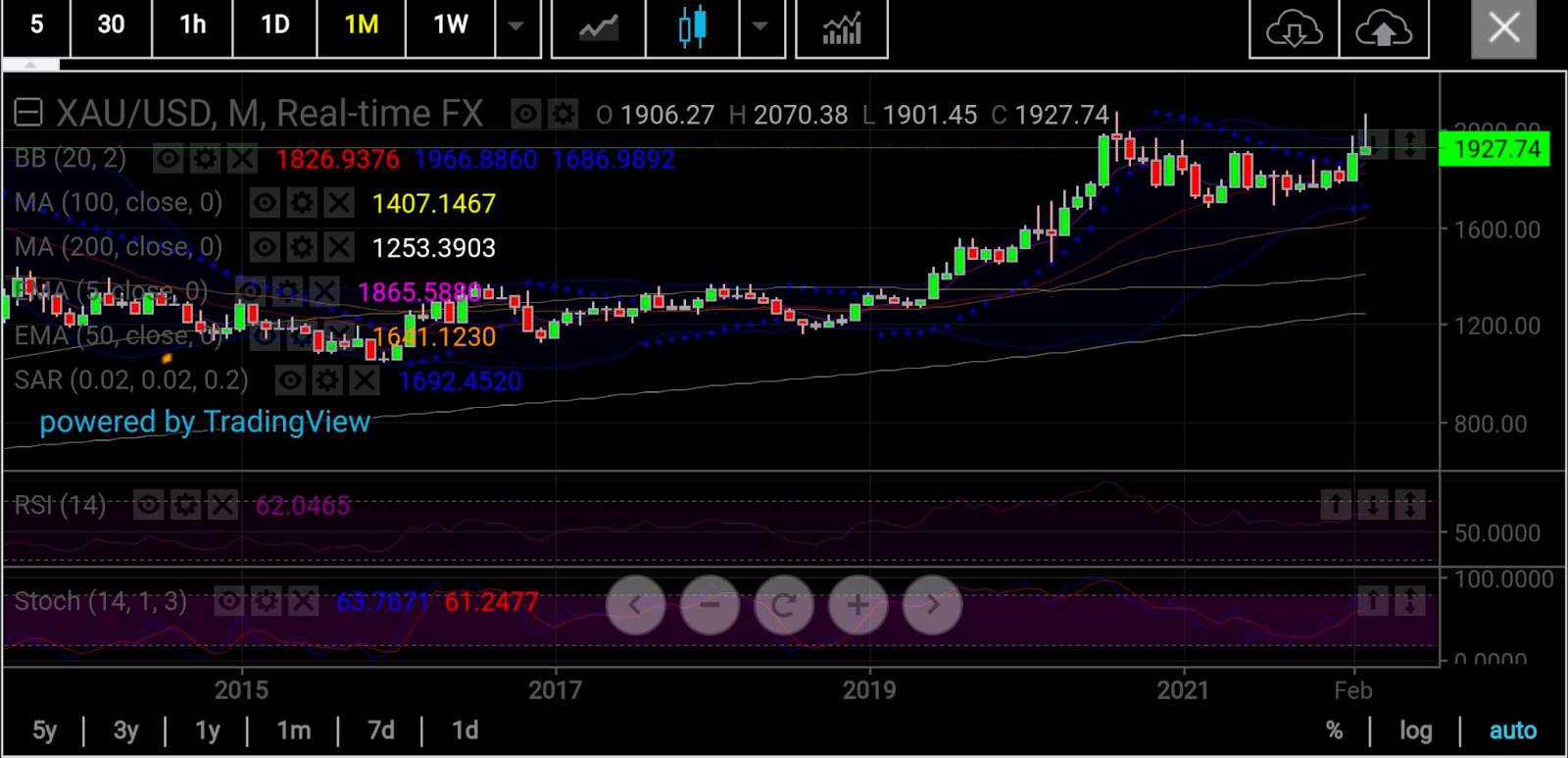Has gold already lost its $2,000 magic?
It seems pretty early to say, though the past four sessions show a market in continuous decline. And technical indicators suggest a greater swoon could come before or right after the first US pandemic-era rate hike expected on Wednesday.
Longs in bullion have lost some 3% since Mar. 10, when COMEX’s front-month gold settled at $2,000.40 an ounce—only the second time in 19 months that it finished at such levels. Until this week’s slide, the expectation had been for a record high above $2,121.
At 3:00 PM Tuesday in Singapore (3:00 AM New York), the benchmark US gold futures contract hovered at below $1,930, near the session low of $1,927.85.
That’s a sheer drop of around $148, or 7%, from this month’s peak of $2,078.80 for COMEX gold that came at the height of the fear factor around the Russia-Ukraine war—which has seen a dramatic decline in tensions in the past 48 hours.

Oil, one of the clearest indicators of the geopolitical heat from the Russia-Ukraine conflict, has lost more than 10% in pricing since Friday, with US crude at well below the key $100 per barrel mark by Tuesday noon in Singapore after Russia’s Sputnik news service said the two warring sides could achieve peace latest by May.
This was despite ELINT News reporting large explosions in Kyiv on Tuesday, citing possible cruise missile strikes.
Investors Slashing Oil Risk, Gold Looks To Follow
Investors’ boldness in pricing down war risks at this point—despite the Russia-Ukraine conflict appearing far from reaching any peaceful conclusion—might not bode too well for gold.
Both US crude and oil’s global benchmark Brent have lost more than 30% since hitting peaks above $130 a barrel on Mar. 8. With gold’s $2,000 ascendancy carrying a fair bit of geopolitical premium as well, many wonder how much more bullion could lose in the next 48 hours before the Federal Reserve announces the tentative US rate hike.
And early technical indicators by skcharting.com’s Sunil Kumar Dixit suggest a drop as low as $1,887 could be likely on the spot price of bullion before or soon after the Fed’s policy decision on Mar. 16.
We’ll get to the nitty-gritty of Dixit’s charts in a while, but first some context on the rate hike and what it entails.

The FOMC is widely expected to raise rates by 25 basis points after leaving them at virtually zero since the COVID-19 outbreak in March 2020. Many economists say that might not be enough.
The test for the Fed and its chairman Jerome Powell will be to curb inflation running at 40-year highs by raising interest rates just enough to cool demand—and not to kill it or send the economy into a recession.
Russia Invasion Makes Things Harder For Fed
Powell’s problem though is that his job has been made remarkably more difficult by Russia’s invasion of Ukraine.
The war, as Bloomberg noted in a commentary last week, has unleashed such turbulence in global financial and energy markets that will be hard to suppress, regardless of the tools in the Fed’s kit—whose remarkable powers Powell never fails to speak of in virtually every speech he makes.
“It’s going to be very tricky,” Moody’s Analytics Chief Economist Mark Zandi was quoted saying by Bloomberg, pointing to rising energy bills—along with slumping stock and credit markets—that could also sap consumer demand, increasing the chances of a recession.
“The economic plane is coming into the tarmac at a very high rate of speed, buffeted by severe crosswinds from the pandemic, with a lot of fog created by uncertainty due to geopolitical events,” Zandi said.
Johan Grahn, head of ETF Strategy at Allianz, also told Investing.com recently that a 25-basis point hike “would be a no decision as opposed to a decision … and it’s not going to pull the handbrake on the inflation momentum.”
Ed Moya from OANDA concurs, saying that while Fed bankers will want to show they’re tackling inflation, they are “not in a position to make aggressive calls on tightening until they have a better handle of the situation.”
Initially winning praise for the Fed’s quick stimulus action that helped prevent the COVID‑19 recession from turning into an outright depression, Powell is now the poster-boy for everything gone wrong with inflation—especially after his admission that the central bank had totally misread the problem as being transitory.
On top of a maximum of seven rate hikes this year—as per the number of FOMC calendar meetings—there is a yet-to-be-specified reduction in the Fed’s balance sheet, which now stands at $8.9 trillion after the central bank loaded up on Treasuries and mortgage-backed securities to support the economy since the Covid outbreak in March 2020.
That action will reduce the cash in the financial system—but it will also bring uncertain consequences for bond and stock markets. The danger is that if inflation doesn’t begin to subside in response to these initial moves, policymakers will end up raising rates too high, sending the economy into a recession and financial markets into a slump.

To surmise, a 25 basis point hike is expected to cause little or no turbulence across markets next week, and possibly embolden risk-takers to creep again at some point into gold and commodities, as well as stocks.
At the same time, a 50 basis point hike will have some serious consequences. Gold and oil will likely plummet anew, amid a renewed crash on Wall Street. Inflation could pause briefly—but more will need to be done if the Fed doesn’t want any subdued price pressure to come roaring back.
If Gold’s $1,925 Support Fails, Next Could Be $1,887
Dixit of skcharting.com says the spot price of bullion, which he uses as basis for his technical outlooks on gold, could reach $1,887 if it doesn’t hold support of $1,925 after Tuesday’s drop to $1,927.85.
“Gold has been falling and doesn't show any strength,” he said.
“This reluctance may be the impact of a double-top formation on the monthly chart when spot gold failed to clear above its previous record high of $2,075.”
Dixit said $1,925-$1,900 was a likely support area that will allow gold a fair ground to consolidate.
“If gold breaks and sustains below $1,925, prices can correct lower to $1,906 and $1,887 which is a good reversal area,” he said, adding that spot gold’s daily chart stochastics were approaching oversold areas.
But on the rebound, $1,970 could act as resistance, he cautioned.
“Gold needs a significant trigger for the resumption of its uptrend, which gains strength only above the $2,010 to $2,030 levels, given the stiff resistance of last week,” said Dixit.
“This week is Fed week, and the most important Fed week since the outbreak of the pandemic. It’s certainly a high-volatility period.”
Disclaimer: Barani Krishnan uses a range of views outside his own to bring diversity to his analysis of any market. For neutrality, he sometimes presents contrarian views and market variables. He does not hold a position in the commodities and securities he writes about.
